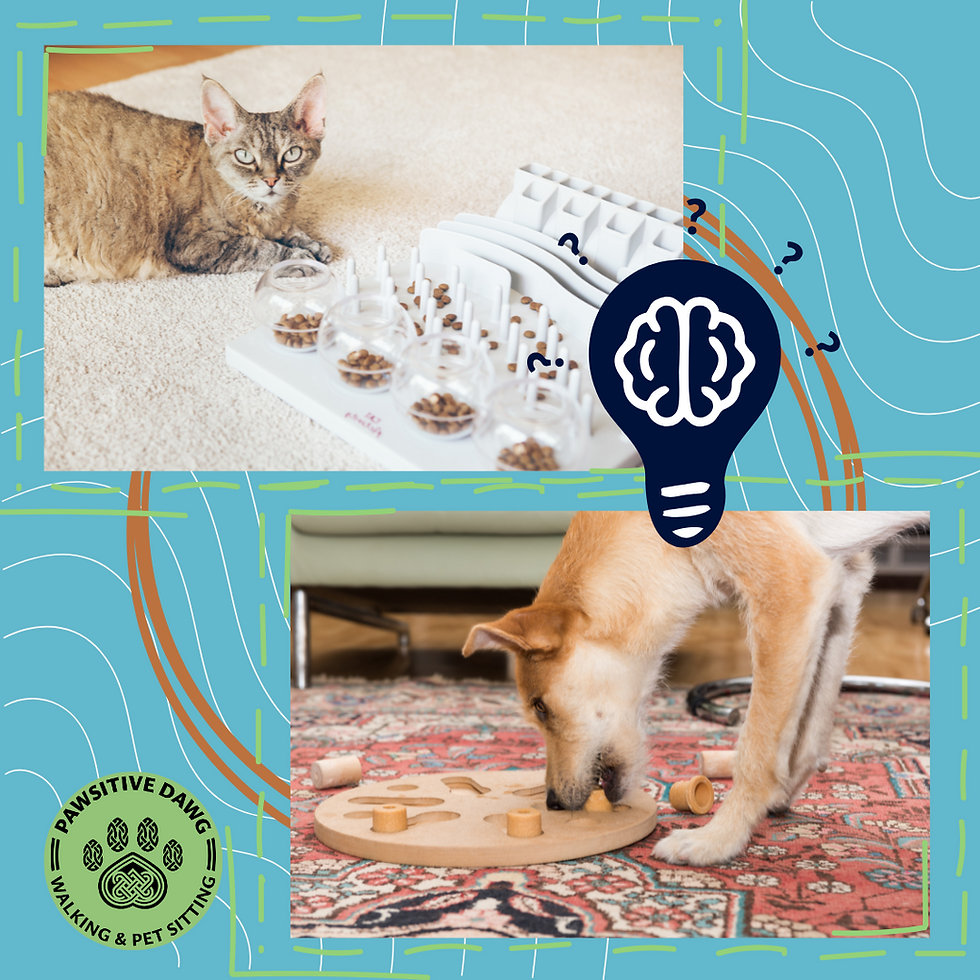How Puzzle Toys Build Confidence & Focus
- The Pawsitive Dawg Walking and Pet Sitting Team

- Jul 12
- 3 min read

If you’ve ever watched a pet figure out a puzzle toy for the first time, you know the magic: the tilted head, the sniff-sniff-snuffle, the wagging tail or focused stare, and then success! Puzzle toys do more than just fill time. They challenge your pet’s brain, promote confidence, and help improve focus and problem-solving skills. Whether you have a shy pup or a curious kitty, the right enrichment can do wonders.
At Pawsitive Dawg Walking and Pet Sitting, we’re big fans of mental enrichment. During our visits, we’re happy to help introduce puzzle toys, supervise play, and even offer guidance on choosing the right toy for your pet’s personality. For pet parents who want more one-on-one support, we can also schedule a personalized training consultation to help you create an enrichment plan tailored to your pet’s needs.
What Types of Puzzles Help Different Pets?
Not all pets enjoy the same type of challenge. Here's how to match the toy to the pet:
Dogs
Beginners: Snuffle mats, simple treat-dispensing balls, or muffin tin games with tennis balls.
Intermediate: Slide puzzles or toys with compartments they need to lift or push.
Advanced: Multi-step puzzles, “lock and key” toys, or toys requiring memory and sequence.
Cats
Beginners: Lick mats, cardboard rolls with hidden treats, or small treat-dispensing balls.
Intermediate: Food puzzles that require batting or nudging to release food.
Advanced: Vertical puzzle towers, hide-and-seek toys, or electronic interactive puzzles.
Enrichment doesn’t need to break the bank either! Many puzzles can be made from things around your house. Ask us for our DIY ideas next time we visit!
How to Introduce Puzzles Step-by-Step
Starting slow and building confidence is the key to success. Here’s a simple intro plan:
Choose the right level: Begin with an easy win. Pick a puzzle that your pet can solve quickly to build motivation.
Demonstrate or guide: For dogs, you can tap or nudge the puzzle pieces to show them the movement. For cats, use your fingers or a toy wand to draw attention.
Keep sessions short and sweet: Start with 5–10 minutes, then end with praise and treats—even if they didn’t quite figure it out yet.
Increase the challenge gradually: Once your pet gets the hang of it, switch up the difficulty, add a new step, or rotate to a different toy.
We’re happy to help your pet practice with puzzles during our visits. Just let us know which ones they like, and we’ll build in some enriching brain time!
Building a Rotation System for Variety
Just like us, pets can get bored with the same toys. A toy rotation system keeps things exciting and maintains mental engagement.
Try this simple system:
Pick 3–5 puzzles your pet enjoys.
Offer one each day, rotating throughout the week.
Every few weeks, swap one out for something new.
If you're unsure where to start, we’d love to help you build a puzzle toy library and recommend a rotation that suits your pet’s personality. You can also schedule a training consultation with our enrichment-savvy team to create a custom confidence-building plan.
Mental Work Brings Out the Best in Pets
When pets are challenged in positive, rewarding ways, they flourish. Puzzle toys provide a sense of accomplishment, reduce anxiety, and give high-energy pets a job to do, helping prevent boredom-based behaviors.
Whether we’re giving your pup a snuffle mat session or setting up a feline food puzzle during a cat sit, our team is here to support your pet’s growth and enrichment journey. Let’s work together to help your pet shine, one puzzle at a time.
Interested in adding puzzle time to your visits or booking a consultation?
Reach out through our conversation feed in your client portal or contact us directly. We’d love to brainstorm some pawsitively fun enrichment ideas with you!








Comments